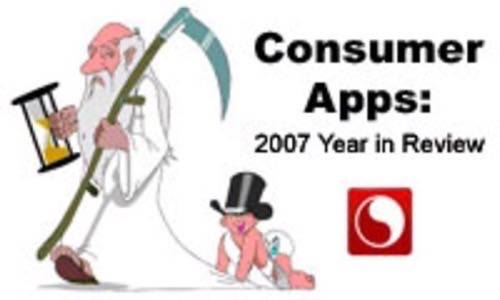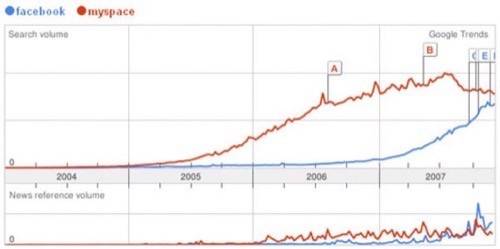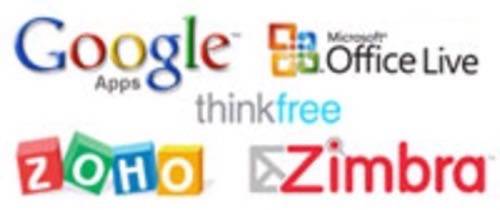“Consumer apps” is a rather broad topic to tackle, so rather than try to recount everything that has happened across the entire cosmos of consumer web applications in the past year, we’ll focus on two areas that have had perhaps the most impact overall in the way we conduct our day-to-day lives: social networking and personal publishing.

Each of those spaces has been led the past year by an innovative, game changing company. In social networking, it was Facebook, in personal publishing, it was Twitter. Indeed, no two companies have impacted the consumer apps space as profoundly this past year as Facebook and Twitter. That’s a large reason why ReadWriteWeb named them this year’s “Best Web BigCo” and “Best Web LittleCo,” respectively.
Social Networking
Social networking has been making headlines for the past few years. In 2005, News Corporation made a huge splash in the social networking market when its Fox Interactive Media division purchased MySpace for a cool $580 million. However, though MySpace remains by far the largest social network on the web, it has been new kid on the block Facebook that has been stealing all the headlines since fall of last year when it opened up beyond the college audience that had been its bread and butter. 2007 was an especially good year for Facebook and the company has made a number of moves that pushed the entire social networking market.
According to Compete, MySpace actually saw traffic fall this year, while Facebook enjoyed a 111% up tick in monthly unique visitors (in the “people count” metric, Facebook showed similar growth). Facebook nearly caught up with its rival in search volume, and overtook MySpace in press mentions by the end of the year.

To what does Facebook owe their amazing growth? In part, perhaps, because of the launch of their platform in May. The platform allowed outside companies to hook into Facebook’s massive user base. Almost immediately we began to hear the success stories, such as iLike, whose application was added by 10,000 users in the first 10 hours of the platform’s existence and by nearly 5 million in the first two months.
Facebook now has over 100,000 application developers working on platform apps, and over 85% of their users have added at least one app to their profile. The success of Facebook’s platform initiative compelled other social networks to consider their own platform strategies. The rumors started to fly. First LinkedIn was getting a platform (which they have finally made good on). Then it was MySpace’s turn. Finally, and most impressively, the world’s second most valuable technology company announced their plans to compete with the Facebook platform.
Google‘s OpenSocial arrived in November with some of Facebook’s biggest competitors as launch partners: Ning, LinkedIn, Hi5, Friendster, orkut, bebo, and the big daddy of the them all, MySpace. However, many of those companies have continued to build out their own platforms and Google’s initiative has so far failed to deliver anything very concrete. Facebook may have had the last laugh when it announced last week that it was opening up its platform architecture. Facebook’s first partner? bebo, an OpenSocial participant.

So influential has Facebook been on the Internet in 2007, that Microsoft agreed to invest $240 million in the company for what amounts to about a 2% stake. This deal shot Facebook’s paper valuation into the stratosphere and gave it the cash it needs to take on competitors like Google and MySpace.
But not everything is rosy for Facebook. Following the launch a controversial new advertising system last month, Facebook faced a backlash from the media and consumer advocacy group MoveOn.org. Even though it appears that Facebook put the issue to rest with an apology and policy change, as Danah Boyd notes, this is the third time in the past couple of years that Facebook has pushed the envelope on privacy issues. They are practicing a form of “slippery slope” software development, she says, and users may not continue to stand for it.
Look for social networking to continue to play a major role in our lives in 2008 as the platform war brewing between Facebook and Google (and the others?) heats up.
Personal Publishing
The other area in the vast consumer application space that was extremely influential this year was that of personal publishing. No one company has been more disruptive than our top LittleCo, Twitter.

A pioneer in the area of “microblogging,” Twitter is, as Alex Iskold recently wrote, a natural evolution of personal publishing that fills the gap between blogging and social networking. Twitter really picked up steam at the SXSW conference last March and has since become something of a phenomenon. In fact, people are even talking about “Twitterdiction” to describe how passionately some users feel about the service.
As we wrote when naming Twitter our best LittleCo of the year, the company truly “stands out as being something that has captured the imagination and become a new hybrid of chat, social networking and blogging.” But perhaps one of the most interesting things that has come out of Twitter, is how it has pushed the creation of an entirely new type of personal publishing.
Probably the second-most talked about microblogging app after Twitter (which some might not really classify as a microblogging app at all — but lets leave semantics aside for now), is Tumblr. Tumblr takes the traditional blog form, and strips it down to a sort of stream of consciousness inspired state in which posts are meant to be short and to the point: a single photo, video, quote, link, or thought. Tumblr certainly wasn’t based on Twitter (it was based on “tumblelogs” like projectionist or Anarchaia), but Twitter’s success really opened the door for more microblogging apps to be developed.

These tools are important because they are highly accessible. Microblogging apps like Tumblr and Twitter are pushing personal publishing into the mainstream in ways that probably hasn’t been done in the past. Though disputed, Forrester Research reported that 6% of US adults use Twitter regularly. That’s remarkable for such a young service (and one that actually has something of a learning curve to really “get”).
Just how important is this new form of personal publishing? Important enough for Google to purchase Twitter rival Jaiku in October for an undisclosed sum.
Other
Facebook and Twitter weren’t the only things to happen in consumer apps this year, just the most disruptive and influential.
IPTV: Another of the most anticipated and talked about startups of the year was Joost. Founded by Janus Friis and Niklas Zennstrom (you know, the Kazaa and Skype guys), Joost is an IPTV service that delivers streaming, on demand television over the Internet using P2P technology. Though they have signed a number of major content deals, including Adult Swim, Warner Bros. Records, the National Basketball Association, and CNN, Joost has yet to really capture the attention of the mainstream. See our full review of Joost, which compares the service to competitors Babelgum and Zattoo and be sure to check out last100’s 2007 Internet TV review.

Politics: Also in 2007, web 2.0 began to play a big role in US presidential politics. Following the trail that Howard Dean blazed in 2004 with his innovative use of blogs and Meetup.com to mobilize grassroots support, this year saw candidates utilizing social web apps as never before. Having a profile on top social networking sites became almost mandatory — almost every major party candidate had a presence on MySpace and Facebook, and some also utilized LinkedIn, Twitter, and others. YouTube held candidate debates with CNN and MySpace got in on the act with their Candidate Dialogues. Some candidates even began broadcasting live on UStream (like Dennis Kucinich or Chris Dodd, for example). The use of consumer web apps in politics is only likely to heat up in 2008 as applications continue to reach more mainstream Americans and the presidential races progress in the United States.
Web Office: Another hot area in the consumer apps space in 2007 was the web office. Because Richard MacManus already wrote a detailed year end wrap-up of that entire market, I’ll be brief in my comments. With the continued maturation of online office suites, especially Google Apps and Zoho, and with Microsoft finally starting to show its online office hand, web office is a very hot sector. And while enterprise customers are who the real battle will be fought over, many of the current crop of offerings are mature enough for home use. Consumers already have access to fairly reliable, fairly complete online word processing, spreadsheet, presentation, and email applications. Be sure to check out Richard’s write up for a more detailed overview of what went down in the web office this past year.

iPhone: Finally, I will take a moment to mention the Apple iPhone. No other product launched this year has captured the imagination of the press and the public like the iPhone, and with good reason. The iPhone has the potential to be a truly game changing gadget that forces other mobile device manufacturers to make a quantum leap in cell phone functionality. One of the areas that the iPhone can make the largest impact is in the adoption of the mobile web via its ability to so elegantly bring the entire Internet to your pocket. Be sure to read Alex Iskold’s list of reasons he loves his iPhone as well as his follow up wish list for the device.

Your Turn
What do you feel were the most impactful consumer apps of 2007? What service or product did we leave off of our wrap up (and there were many!) that you think we really should have paid more attention to? What do you think will be the big trends of 2008? Let us know in the comments below.










